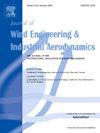Advancements in the physical simulation of near-surface extreme wind phenomena using hybrid active-passive flow control in a large boundary layer wind tunnel
IF 4.2
2区 工程技术
Q1 ENGINEERING, CIVIL
Journal of Wind Engineering and Industrial Aerodynamics
Pub Date : 2025-02-19
DOI:10.1016/j.jweia.2024.105997
引用次数: 0
Abstract
This paper presents advancements in the reduced-scale physical simulation of near-surface synoptic and non-synoptic extreme wind phenomena in a long-fetch boundary layer wind tunnel (BLWT). This research was carried out at the University of Florida's BLWT, which is one of the National Science Foundation's (NSF) Natural Hazards Engineering Research Infrastructure (NHERI) Experimental Facilities (EF). Flow fields in the UF BLWT are created by three computer-controlled flow-conditioning stages: vaneaxial fans (VAF), automated roughness elements collectively called the Terraformer (TF), and a multi-fan array called the Flow Field Modulator (FFM). The VAF and TF together can generate traditional BLWT log law atmospheric surface layer (ASL) wind velocity profiles. The FFM provides additional mean flow shaping, active turbulence modulation, and the ability to create nonstationary flow fields toward simulating non-synoptic events. A novel governing convergence algorithm (GCA) was developed to provide seamless closed-loop control of the three flow-conditioning stages toward achieving target profiles in the downwind test section. Three case studies covering a broad range of target flow conditions are demonstrated. The first case is a stationary non-monotonic mean target profile, illustrating the mean flow shaping capabilities of the GCA. The second case is a nonstationary non-monotonic transitioning flow, illustrating how the FFM can be used to transition between two GCA-converged targets. The third case is a stationary ASL flow profile where the GCA is used to converge longitudinal mean, turbulence intensity, and integral length scale profiles simultaneously. The results demonstrate that a multi-stage flow control approach with closed-loop convergence can achieve user-specified complex and transient flow conditions. The resultant flow capabilities expand the traditional limits of flow simulation, bringing the breadth of behaviors in real wind events and our controlled study of them closer together.
大型边界层风洞中主被动混合流动控制近地面极端风现象物理模拟研究进展
本文介绍了长时间边界层风洞近地面天气和非天气极端风现象的小尺度物理模拟研究进展。这项研究是在美国国家科学基金会(NSF)自然灾害工程研究基础设施(NHERI)实验设施(EF)之一的佛罗里达大学BLWT进行的。UF BLWT中的流场由三个计算机控制的流调节级产生:叶片轴流风机(VAF),统称为地形变换器(TF)的自动粗糙度元件,以及称为流场调制器(FFM)的多风扇阵列。VAF和TF可以共同生成传统的BLWT对数法大气表层风速廓线。FFM提供了额外的平均流整形、主动湍流调制和创建非平稳流场的能力,以模拟非天气事件。开发了一种新的控制收敛算法(GCA),为三个流动调节阶段提供无缝闭环控制,以实现顺风测试段的目标剖面。三个案例研究涵盖了广泛的目标流动条件。第一种情况是一个平稳的非单调平均目标轮廓,说明了GCA的平均流整形能力。第二种情况是一个非平稳非单调过渡流,说明FFM如何用于两个gca收敛目标之间的过渡。第三种情况是固定的ASL流型,其中GCA用于同时收敛纵向平均、湍流强度和积分长度尺度的流型。结果表明,一种闭环收敛的多级流动控制方法可以满足用户指定的复杂瞬态流动条件。由此产生的流动能力扩展了流动模拟的传统限制,将真实风事件的行为广度和我们对它们的控制研究更紧密地结合在一起。
本文章由计算机程序翻译,如有差异,请以英文原文为准。
求助全文
约1分钟内获得全文
求助全文
来源期刊
CiteScore
8.90
自引率
22.90%
发文量
306
审稿时长
4.4 months
期刊介绍:
The objective of the journal is to provide a means for the publication and interchange of information, on an international basis, on all those aspects of wind engineering that are included in the activities of the International Association for Wind Engineering http://www.iawe.org/. These are: social and economic impact of wind effects; wind characteristics and structure, local wind environments, wind loads and structural response, diffusion, pollutant dispersion and matter transport, wind effects on building heat loss and ventilation, wind effects on transport systems, aerodynamic aspects of wind energy generation, and codification of wind effects.
Papers on these subjects describing full-scale measurements, wind-tunnel simulation studies, computational or theoretical methods are published, as well as papers dealing with the development of techniques and apparatus for wind engineering experiments.

 求助内容:
求助内容: 应助结果提醒方式:
应助结果提醒方式:


